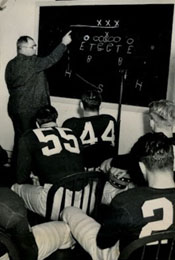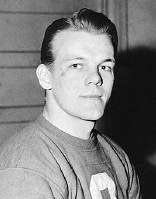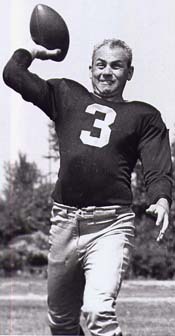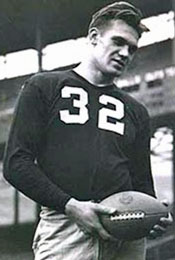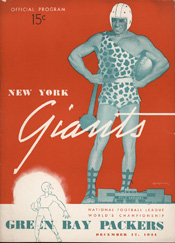Note: The gray boxes contain asides that provide interesting material but could be skipped without losing the continuity of the article.
|
|
By 1944, the toughest opponent facing every NFL team was World War II. Teams struggled to find quality players even after reducing the rosters to 25 for the '43 season. For example, the Giants had only five players left from their 1941 East Division champions.
One of those five was All-Pro C Mel Hein, who retired after the 1942 season and took a job with the Navy training program at Union College in Schenectady NY. But Giants coach Steve Owen called Mel before the '43 season and enticed him to become his "Sunday Center." He spent the week in Schenectady but played in each week's game. Mel recalled: This may sound like a precarious arrangement for Steve, but I had played under him so long I knew the system inside out. And my work at Union kept me in shape. So the team accepted the same arrangement for '44.
Yet with the situation worse in '44, what did the NFL owners decide to do for 1944? Expand!
The owners agreed on three rules changes.
The East race went down to the last weekend.
Applying a statistic that wasn't in vogue in the '40s, it is ironic that the Packers made the championship game in 1944 after not making it the previous three years. The 1941, '42, and '43 Green Bay teams rank in the top ten all-time in turnover differential, accepted today as one of the best indicators of success in football.
The Giants returned to the championship game for the first time since 1941.
The Packers, like the Giants, were a shadow of their teams that won championships before the war.
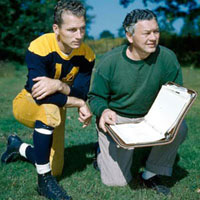 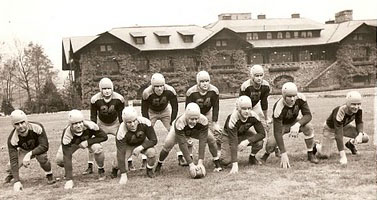 L: Don Hutson and Curly Lambeau; R; Packers' starting offense. Despite losing to New York in the regular season and having to travel to the Polo Grounds again (because it was the East champion's turn to host), the Packers ruled as slight favorites (8 to 5).
Curly took his team to Charlottesville VA for nine days of practice in milder weather at the University of Virginia before traveling to the Big Apple.
The league decreed that, should the game end in a tie, there would be no overtime, and the teams would be declared co-champions. |
|
|
||||||||||||||||||||||||||||||||||||||||||||||||||||||||||||||||||||||||||||||||||||||||||||||||||||||||||||||||||||||||||||||||||||||||||||||||||||||||||||||||||||||||||||||||||||||||||||||||||||||||||||||||||||||||||||||||||||||||||||||||||||||||||||||||||||||||||||||||||||||||||||||||||||||||||||||||||||||||||||||||||||||||||||||||||||||||||||||||||||||||||||||||||||||||||||||||||||||||||||||||||||||||||||||||||||
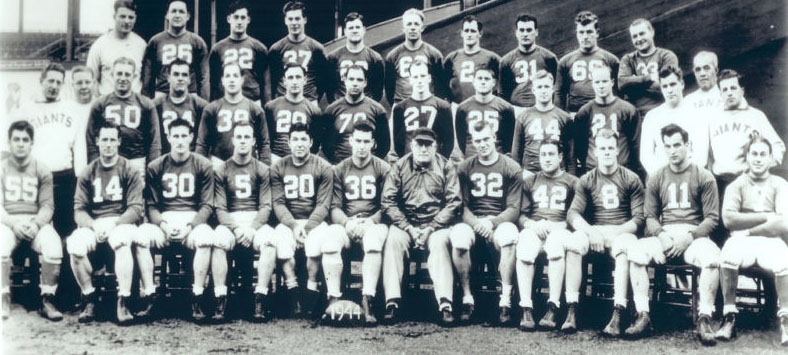
- Quarter 1
While the Giants had shown the superior line play in the earlier meeting between the teams, it was obvious from the start that the Packers' front had more zing this time. The home team also suffered from losing their rookie LB Len Calligaro to a shoulder injury on the first play he was in.
The home team deployed a five-man line but, when they suspected a pass, had all-league G Len Younce drop back to help cover Hutson. In those cases, GB sent either HB Laws or FB Fritsch through the gap for good gains.
In the first period, the Giants got the ball at their 2, 19, 21, 30, and 11, but each time had to punt.
Meanwhile, the Packers didn't have much more success themselves. They did manage to grind out two first downs. Their deepest penetration came after Irv Comp returned Younce's punt 9y to the GB 44. The first play was a pass from Comp into the flat to Hutson, who fooled the Giant defenders completely. But Don slipped after making the catch and slid out of bounds after a 22y gain. But Irv's protection failed him on the next play, and he was hit from the blind side just as he let the ball go. Younce intercepted the throw.
Finally, after forcing still another punt, the Packers began a scoring drive from the NY 48.
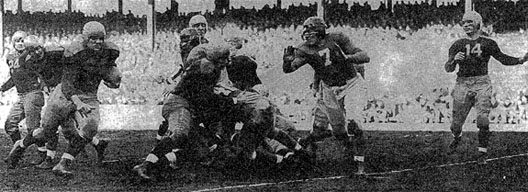
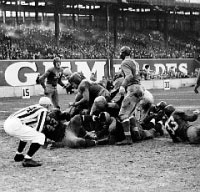
L: Ted Frisch runs 26y to the 1. R: Fritsch scores for Packers.
- Quarter 2
The period had hardly started when Laws, who would be the game's leading ground-gainer (13/78), churned 20y off right tackle on a spinner to the NY 28. On the next play, Fritsch, "a squat 210 pounder," broke through the same hole and broke into the clear. At the 10, he met Cuff head on, bounced the Giant out of his path, and kept goining until Howie Livingston pulled him down at the 1. Laws slipped on first down and lost a yard. Then Fritsch lost another before Joe gained nothing. Green Bay called timeout and decided to eschew the field goal. Lou Brock replaced Laws, but Fritsch got the ball and followed Brock and Charley "Buckets" Goldenberg, 33-year-old BB with 12 years of service under his belt, through a hole at right guard and ended up 3 or 4y in the end zone. Hutson booted the PAT. Packers 7 Giants 0
Later in the period, Green Bay cleverly took advantage of the Giants' obsession with Hutson to double their score in the last two minutes with a 63y drive. The first key play occurred with the ball at the GB 45. Comp, under a furious rush all afternoon, threw to Hutson who made a sensational catch to put the ball at the 30. After Fritsch's 2y gain, the Packers pulled off the play of the game. Comp took the snap and, as his line swung to the right, watched Hutson break across from left end, drawing defenders with him. In the meantime, Fritsch sauntered unnoticed to the left, then began to sprint down the sidelines. Comp, after faking several times toward Don, turned and threw toward Ted, who took the pass at the 11 with no one within 10y of him and ambled into the end zone. Hutson booted the point. Packers 14 Giants 0 with a minute and a half to play.The Giants could kick themselves because they had been practicing a defense against plays that used Don as a decoy. They knew what to expect and what to do, but they just didn't do it.Since NY ended the half having gained only 24y without once moving beyond their own 35, the lead seemed insurmountable, especially with every prospect that the Pack would add more points. The Giants had also lost 30y by penalties for excessive times out.
Hutson had a tendency to loaf a little if a pass wasn't supposed to go to him. But on the touchdown pass to Fritsch, Hutson didn't know he wasn't the primary receiver. So he ran a crossing pattern at full speed and took both a defensive back and a linebacker with him.
Richardson used World War II analogies in his Times article the next day to describe the home team's woeful performance. For the first thirty minutes ..., the Giants were like a ship on the run to Murmansk without rudder or guns ... Kept handcuffed, hog-tied and hamstrung all through the first two periods ..., the Giants ... came out after the intermission and outfought their able-bodied opponents from there on.
- Quarter 3
After participating in only three plays in the first half, Paschal tried to go, but his ankle gave way on the first scrimmage play. Despite his loss, the Giants offense finally showed some spark, gaining their initial first down on a pass down the middle from Herber to Cuff, who ran to midfield. But that's as far as the Giants got since three passes by Arne failed to connect, forcing them to punt.
The next time NY got the ball, they moved from their 14 to a first down on the GB 42 in four plays. This time Laws stopped the thrust by intercepting his former teammate's toss, one of Joe's three picks on the day.
The home team got their mitts on the ball again when Livingston reached his big paws into the path of a Comp pass toward Hutson and lumbered up the field until dumped on the NY 45. From there, the Giants embarked on their first scoring march. First, Herber fired a pass that fell incomplete, but the officials ruled interference on the GB 42. Then Arne arched a long one to E Frank Liebel. Comp had him covered but, as he reached to intercept, slipped on the wet field and went down on his backside with a crash, enabling Frank to make the catch on the 12. He nearly scored, but Fritsch ran him out of bounds on the 1 as the period ended.
- Quarter 4
Moving from WB to TB for one play only, Cuff plowed across up the middle to open the period. Strong's PAT cut the Green Bay lead in half. Packers 14 Giants 7
Neither team could move. The Packers were playing conservatively and eating up clock, but NY filled the air with passes - Herber would complete only 8 of 22.
The Giants started one drive only to have Laws intercept on his own 35.
On their next possession, the home team gained three first downs, the last one at the GB 42 before the advance was halted when Paul Duhart recorded the Pack's fourth INT at the 20 with less than five minutes left.
In the closing minutes, the Giants opened up again, completing two passes. But a 4th down shovel pass from Herber to Cuff gained only 4y when they need 7, and the Packers took over.
On the first snap, the game ended.
FINAL SCORE: PACKERS 14 GIANTS 7
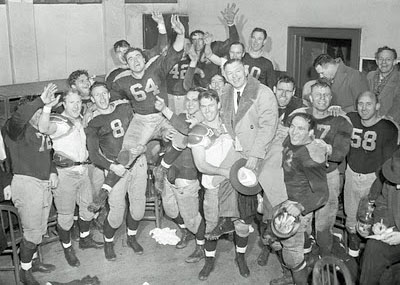 Packers hoist Fritsch and Lambeau. |
Final statistics:
The game broke all records financially.
|
- Louis Effrat of the NY Times waited for the Packers in their locker room. First to reach the visiting team's dressing room ... was Bill Kuusisto, the 230-pound guard from Minnesota, but one needed more than a second look to identify the player. The left side of his face was ripped and puffed and over his left eye was the nastiest gash imaginable, evidence of the savage line play that marked this play-off encounter. Hutson's right elbow and thigh sported nasty contusions.
- Lambeau praised the Giants as a "great club," then turned to his own club. The mental attitude of the teams had a lot to do with the outcome. This time we were "up" for the game. The last time the Giants were "up." ... For the first time this year, the ball club operated at full efficiency. ... On defense, all the boys were superb. Special credit should be given to Larry Craig, whose trap blocking on runs by Joe Laws up the middle paved the way for Joe. Concerning the second TD when Fritsch sneaked out of the backfield, Curly chuckled. I guess you could call that our secret weapon. Asked who should get the game ball, Curly replied, Give it to "Baby" Ray[GB's 6-6, 249lb T from Vanderbilt]. I promised it to him earlier in the year. He was referring to the exhibition game GB played against the Eagles in Nashville, Baby's home town, which proclaimed it "Baby Ray Day." We played so poorly then and disgraced Ray before his neighbors. So I promised him the championship ball.
- Hutson, who caught only two passes (with one completion negated by penalty): Don't let any one tell you the Giants are not a good team. Defensively, they are the best in the league. They always hamper our offense when we play them ... You'll never see me play another game of football in New York. I'm through for good this time. I've got a coaching contract with Curly and from now on that's what I'm going to do. Considering this was Don's fourth "annual retirement," interviewers were not inclined to take this declaration seriously. But the great E reiterated: If I play another game here, you can push me off the top of the Empire State Building, and I'll give you thirty minutes in which to collect a crowd. When informed of Hutson's words, Lambeau merely laughed. Oh, Don always talks like that after the last game. But don't fret. He'll be back.
- Chicago Cardinals coach Phil Handler, in attendance at the game, said, I thought Laws was the best player on the field. Why, he actually looked faster than when he broke into pro football.
- Owen in his somber locker room intimated that the loss of Paschal and Calligaro changed the complexion of the game but gave the Packers due credit. We didn't have it today. They did. We were bottled in our own territory throughout the first half and had to kick on third down repeatedly. Without Paschal to threaten them, the Packers were able to play wide open. We went as far as we could.

- The Packers split a pool of $41,896.64 - about $1,500 per man.
- The losers divided $27,938.91 ($900 each).
- Both amounts set new records.
- Al Blozis was killed in the Battle of the Bulge on January 31, 1945, a little over a month after playing in the championship game.
- As Lambeau suspected, Hutson returned for the '45 season, but that was it. He was inducted into the Pro Football Hall of Fame as a member of its inaugural class in 1963.
Green Bay Packers: A Measure of Greatness, Eric Goska (2004)
Top of Page

